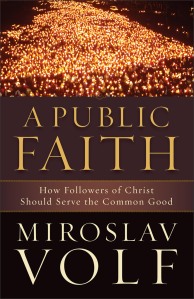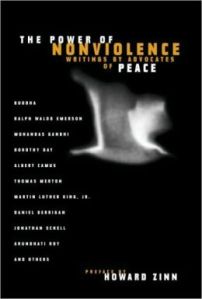 Near the end of A Public Faith: How Followers of Christ Should Serve the Common Good, theologian Miroslav Volf considers what is needed for people of various religions to engage in dialogue or to share public space without turning to violence.
Near the end of A Public Faith: How Followers of Christ Should Serve the Common Good, theologian Miroslav Volf considers what is needed for people of various religions to engage in dialogue or to share public space without turning to violence.
The only way to attend to the problem of violent clashes among differing perspectives on life–whether religious or secular–is to concentrate on the internal resources of each for fostering a culture of peace.[1] For each, these resources would be different, though again they may significantly overlap. (p. 132)
That is, every religion has a unique basket of resources that can be useful for making peace. Each basket will have something in common with each of the other baskets, and they will each have resources not directly shared with the others. Therefore, followers of each religion need to utilize what is found in their own basket when encountering “the other” or experiencing conflict (which should be differentiated from “violence”).
I first encountered this general argument while reading Peacemakers in Action: Profiles of Religion in Conflict Resolution (David Little, Ed., 2007) while working on an independent study in grad school. In the concluding chapter (“Religion, Violent Conflict, and Peacemaking”), Little attempts to bring together the central themes that emerged in the material presented by the various contributing authors (roughly 400 pages of historical accounts of religion in violence and peacemaking). The first commonality between the peacemakers is a hermeneutics of peace, “an interpretive framework that begins with the conviction that the pursuit of justice and peace by peaceful means is a sacred priority in each of the traditions presented” (p. 438). The books’ narratives demonstrate that in the real world–and not just in books by theologians such as Volf–believers of various religions do in fact find resources which support peacemaking.
Maybe it is worth noting the flow or evolution in the conversation with a series of questions:
- Must Christianity (and all religions) be violent?[2]
- What set of peacemaking resources are available for adherents of each religion or worldview?
- Despite these resources, why are religions so often associated with violence?
- If a hermeneutic of peace must be constructed, is it really at the center of each (any?) religion or is it merely imposed on the religion by overly optimistic or sentimental peaceniks?
- How can people of goodwill encourage others to develop a hermeneutic of peace?
Wee have already answered the first question by noting the collection of essays edited by David Little. These accounts demonstrate that religion can be a tremendous nonviolent force for peace and justice.[3]
The second question is best answered by adherents of each religion, meaning I am not prepared to provide a list here (lacking specific knowledge, general wisdom, and time to list the resources I am currently aware of). However, I do appreciate how Volf answers this question regarding Christianity, noting two resources in particular. We’ll briefly explore the first of the two here.[4]
In regard to the Christian faith–the faith I embrace and study and the faith that is a good contender for having a legacy as violent as any other–developing its resources for fostering a culture of peace would mean at least two things. The first concerns the center of faith. From the very start, at the center of Christian faith was some version of the claim that God loved the sinful world and that Christ died for the ungodly (John 3:16; Rom. 5:6), and that Christ’s followers must love their enemies no less than they love themselves. Love doesn’t mean agreement and approval; it means benevolence and beneficence, possible disagreement and disapproval notwithstanding. A combination of moral clarity that does not shy away from calling evil by its proper name and of deep compassion toward evildoers that is willing to sacrifice one’s own life on their behalf was one of the extraordinary features of early Christianity. It should also be the central characteristic of contemporary Christianity. (p. 132)
If you are a Christian, do you agree with this description of the “center” of an orthodox Christian faith? How would you buttress or counter this assertion? If you disagree, what do you see as the center, and how does this impact Christianity’s ability to be a force the common good?
If you are an adherent of another faith tradition, what do you see as the resources for peace within your tradition? What are the most obvious tenets or tools? What elements require more imagination or “work” in order to be viewed as seeds of peace? What appears to foster violence or conflict more than peace, reconciliation or harmony?
Turning to the third question, why are religions so often violent if they have such profound resources for peacemaking? This is a grand question that deserves blog posts and books and libraries, but most simply I believe there are two reasons for the connection. (1) Most religious texts include descriptions of violence and use violence as a metaphor even when not directly addressing the topic of violence. For example, Christians wrestle with the “holy wars” of David and Joshua (as do Jewish peacemakers) as well as Paul’s war metaphors (e.g., armor of God in Ephesians 6:13-15). Even people desiring peace must wrestle with “sacred” material that does not sound very peaceful. This is where Little’s “hermeneutics of peace” is used. With this “framework, particular texts, doctrines, and practices contained in one’s own tradition–and often in the traditions of others–are examined for guidance in the process of elaborating and implementing the fundamental commitment to peace and justice” (Peacemakers in Action, p. 438). (2) People of all religions and worldviews share common emotions of anger and hatred with desires for revenge, which are all natural reactions to both real and perceived injustices. Resources for peacemaking are up against a mighty challenge that is the wounded human heart. Certainly, other reasons could be cited as well, but these–the religious texts and the human heart–are sufficient for the present purposes.
This point leads us to the fourth question–if a hermeneutic of peace must be constructed, is it really at the authentic center of each religion? This presents the struggle to properly (or effectively?) interpret the religious texts and traditions that have been handed down to us. Christians have used the Bible to argue for and against a number of social issues, including slavery, various wars (and war in general), women’s rights, environmental protection, and laissez-faire capitalism. Similarly, writings in Jewish and Islamic traditions have been used to advocate both peace and violence. Moving beyond the Abrahamic faiths, as a Hindu, Gandhi turned to the Bhagavad Gita (in addition to the Sermon on the Mount) for continual inspiration for nonviolent peace- and justice-making despite the Gita’s battlefield setting.[5] A lay person may be tempted to conclude that conclusions about interpretation likely say more about the interpreter than about the actual text under consideration.
This raises an important topic for interpreters of faith, the difference between what theologians call exegesis and eisegesis, though at a more macro level than is usually meant by these terms. Briefly, exegesis is the process of studying a passage of scripture to understand what it means, what the author was originally attempting to communicate. Alternatively, eisegesis is reading into a verse one’s own meaning. We battle this same tension at the level of determining the overall meaning or purpose of God and our particular religion. Christians struggle to determine what we believe God intended as the center of Christianity, not just what we want it to be. Guidance for undertaking this important work is beyond the scope of this post; I simply want to highlight the struggle and the call for humility that our limits demand.
Regarding Volf’s assertion regarding Christianity’s first peace resource, questions that arise include: Is “serving the common good” Christianity’s purpose, or is that an imposition of a modern value onto an ancient text? Since it is so easy to interpret Christianity in a way that supports either violence or peace, how do we know whether we are taking meaning from the Bible or reading our meaning into it? Presuming “Christianity” proceeded from “God,” how do we know whether God intended the movement to be one of peace? What is our hermeneutic of peace and how is it established?[6]
This line of questioning naturally moves toward the fifth question listed above: If we are convinced that peace and justice are central to our faith, how do we convince others within our religion who care little for such themes. Returning to Volf to address this question, I believe their is wisdom in his assertion that we need a “hermeneutical hospitality” (p. 136). This approach is not only important in inter-faith dialogue, but also in intra-faith conversation. Volf describes hermeneutical hospitality in this way:
Each should enter sympathetically into others’ efforts to interpret their sacred texts as well as listen to how others perceive them as readers of their own sacred texts. Such hospitality will not necessarily lead to agreement in the interpretation of each other’s respective scriptures. And it will certainly not lead to overall agreement among different religious communities for the simple reason that they hold distinct–even if, in some cases, partly overlapping–texts as authoritative. But such hermeneutical exchanges of gifts will help people of faith to better understand their own and others’ sacred texts, to see each other as companions rather than combatants in the struggle for truth, to better respect each other’s humanness, and to practice beneficence toward one another. (p. 136)
Here we see both give and take, sharing and listening. Gifts are given in both directions. Am I willing to receive or only to give? Am I willing to listen to people who view topics of peace and justice differently than I do? Am I willing to listen to people who hold a religion that is very different from mine? Stephen Covey may not have had world religions, peace, justice and violence in mind when he wrote his best seller, The 7 Habits of Highly Effective People, but in the end Volf and Covey aren’t so far from each other–“Seek first to understand, then to be understood.”
– – –
[1] Volf here points the reader to consider, A Common Word: Muslims and Christians on Loving God and Neighbor (2009).
[2] See Chase & Jacob, 2003.
[3] See also Disruptive Religion, Smith, 1996.
[4] The second resource focuses on “identity,” which relates to boundaries. This feature seems to relate to all traditions or people, so I am not addressing it directly here, though I do think it is an incredibly important topic. Maybe I’ll focus on it in a future post.
[5] For more about Gandhian interpretations of the Bhagavad Gita and Hinduism more broadly, see the first two chapters of Gandhi and Jesus (Rynne, 2008).
[6] I have previously posted thoughts on this topic at Spectrum — “Theology of Peace” Part 1 | Part 2 | Part 3.
 Here are a few lines from a book I started recently,
Here are a few lines from a book I started recently, 